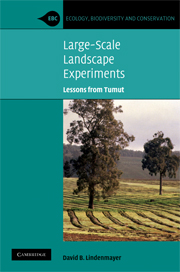Book contents
- Frontmatter
- Contents
- Preface
- Acknowledgements
- 1 The science of understanding landscape change: setting the scene for the Tumut Fragmentation Study
- 2 The theory: an overview of landscape change and habitat fragmentation
- 3 The field laboratory: the Tumut study area and the vertebrate animals it supports
- 4 Setting up the study: the design and implementation of the main cross-sectional study at Tumut
- 5 The core findings: the effects of landscape context on animals and plants
- 6 Patch use: how animals use patches of remnant eucalypt forest surrounded by pine
- 7 Theory against data: testing ecological theories and concepts
- 8 Testing PVA models with real data: melding demographic work with population modelling
- 9 Genes in the landscape: integrating genetic and demographic analyses
- 10 Refining and extending the research programme: additional studies at Tumut (and nearby) that build on the Fragmentation Study
- 11 Recommendations for plantation managers: implications for biodiversity and conservation in plantations
- 12 Lessons on running large-scale research studies: some insights from running the Tumut Fragmentation Study and directions for the future
- Appendix 1 List of collaborators/contributors to the Tumut Fragmentation Experiment
- Appendix 2 Detections of bird species in the Tumut Fragmentation Study classified by four broad classes of sites
- References
- Index
3 - The field laboratory: the Tumut study area and the vertebrate animals it supports
Published online by Cambridge University Press: 20 May 2010
- Frontmatter
- Contents
- Preface
- Acknowledgements
- 1 The science of understanding landscape change: setting the scene for the Tumut Fragmentation Study
- 2 The theory: an overview of landscape change and habitat fragmentation
- 3 The field laboratory: the Tumut study area and the vertebrate animals it supports
- 4 Setting up the study: the design and implementation of the main cross-sectional study at Tumut
- 5 The core findings: the effects of landscape context on animals and plants
- 6 Patch use: how animals use patches of remnant eucalypt forest surrounded by pine
- 7 Theory against data: testing ecological theories and concepts
- 8 Testing PVA models with real data: melding demographic work with population modelling
- 9 Genes in the landscape: integrating genetic and demographic analyses
- 10 Refining and extending the research programme: additional studies at Tumut (and nearby) that build on the Fragmentation Study
- 11 Recommendations for plantation managers: implications for biodiversity and conservation in plantations
- 12 Lessons on running large-scale research studies: some insights from running the Tumut Fragmentation Study and directions for the future
- Appendix 1 List of collaborators/contributors to the Tumut Fragmentation Experiment
- Appendix 2 Detections of bird species in the Tumut Fragmentation Study classified by four broad classes of sites
- References
- Index
Summary
This chapter outlines some of the key features of the study region, including types and patterns of vegetation cover and attributes of some of the flora and fauna. More detail is provided on those species targeted for detailed research.
Geology and climate
The work at Tumut was focused in and around the Buccleuch State Forest, which lies 100 km west of Canberra in southern New South Wales (NSW), south-eastern Australia (Figure 3.1). The total area under investigation encompasses ~100,000 ha and its midpoint is 148°40′E, 35°10′S.
The Tumut study area is characterised by an elevation gradient of 400–1,200 m above sea level. The terrain varies from mountainous and steep to undulating. Permanent streams flow through the valleys of the region, and there are also semi-permanent wetlands and soaks (Parris and Lindenmayer, 2004).
Two climate domains, as defined by the Köppen Climate Classification System, can be found at Tumut (Dick, 1975), with rainfall distributed evenly across the year and either cool or hot summers. A detailed analysis using the climate projection system BIOCLIM (Nix and Switzer, 1991) shows that the estimated mean annual temperature varies from 9.6 to 13.8°C and the annual mean precipitation from 785 to 1,385 mm.
The geology underlying Buccleuch State Forest and its immediate surrounds is dominated by granites interspersed with limited Tertiary alluvial and volcanic deposits.
- Type
- Chapter
- Information
- Large-Scale Landscape ExperimentsLessons from Tumut, pp. 39 - 66Publisher: Cambridge University PressPrint publication year: 2009



